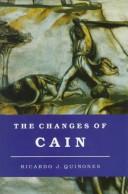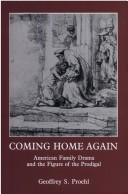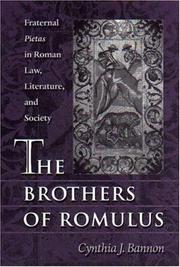| Listing 1 - 3 of 3 |
Sort by
|

ISBN: 0691634718 1400862140 0691068836 0691015023 0691605793 9781400862146 9780691068831 9780691015026 9780691605791 Year: 1991 Publisher: Princeton, New Jersey
Abstract | Keywords | Export | Availability | Bookmark
 Loading...
Loading...Choose an application
- Reference Manager
- EndNote
- RefWorks (Direct export to RefWorks)
Era by era, from the writings of the classical Christian epoch up to East of Eden and Amadeus, from Philo to Finnegans Wake, Ricardo Quinones examines the contexts of a master metaphor of our culture. This brilliant work is the first comprehensive book on the Cain and Abel story."Ricardo Quinones takes us on a grand tour of Western civilization in his admirable book, which reveals the riches of the Cain-Abel story as it develops from its Biblical origin to Citizen Kane and Michel Tournier. This is cultural history and literary criticism of the first order, finely written, formidably but gracefully erudite, and illustrating the capacity of Judeo-Christian culture and the modernity emerging from it constantly to criticize the darker side of its own foundations and realizations."--Joseph Frank"Ricardo J. Quinones skips Biblical and Talmudic exegesis to follow Cain and Abel through later centuries, from classical times to the present. What he uncovers sheds light on important shifts of consciousness and behavior in European and American culture. . . . Quinones writes with true eloquence and conviction. . . ."--James Finn Cotter, The Hudson Review"Quinones's study of how [the] three Cains were transformed by Romanticism and Modernism into a sometimes positive, sometimes negative, but always necessary archetype of the modern world is literary and cultural analytic history at its very best."--ChoiceRicardo J. Quinones is Josephine Olp Weeks Professor of English and Comparative Literatures, and Director of the Gould Center for Humanistic Studies, at Claremont McKenna College in Claremont, California. He is the author of The Renaissance Discovery of Time (Harvard), Dante Alighieri (Twayne), and Mapping Literary Modernism: Time and Development (Princeton).Originally published in 1991.The Princeton Legacy Library uses the latest print-on-demand technology to again make available previously out-of-print books from the distinguished backlist of Princeton University Press. These editions preserve the original texts of these important books while presenting them in durable paperback and hardcover editions. The goal of the Princeton Legacy Library is to vastly increase access to the rich scholarly heritage found in the thousands of books published by Princeton University Press since its founding in 1905.
Abel -- (Biblical figure) -- In literature. --- Bible. -- Genesis IV, 1-15 -- Criticism, interpretation, etc. --- Brothers in literature. --- Cain -- (Biblical figure) -- In literature. --- Human sacrifice in literature. --- Violence in literature. --- Frères dans la littérature --- Violence dans la littérature --- Sacrifice humain dans la littérature --- Cain --- Abel --- Violence dans la littérature --- Sacrifice humain dans la littérature --- Frères dans la littérature --- In literature. --- Bible. --- Criticism, interpretation, etc.

ISBN: 0838635474 Year: 1997 Publisher: Madison, NJ : London ; Cranbury, NJ : Fairleigh Dickinson University Press ; Associated University Presses,
Abstract | Keywords | Export | Availability | Bookmark
 Loading...
Loading...Choose an application
- Reference Manager
- EndNote
- RefWorks (Direct export to RefWorks)
Domestic drama, American --- Husbands in literature --- Brothers in literature --- Prodigal son (Parable) --- Families in literature --- Return in literature --- Home in literature --- Sons in literature. --- Théâtre bourgeois américain --- Maris dans la littérature --- Frères dans la littérature --- Enfant prodigue (Parabole) --- Familles dans la littérature --- Retour dans la littérature --- Foyer dans la littérature --- Fils dans la littérature --- History and criticism --- Histoire et critique --- Théâtre bourgeois américain --- Maris dans la littérature --- Frères dans la littérature --- Familles dans la littérature --- Retour dans la littérature --- Foyer dans la littérature --- Fils dans la littérature

ISBN: 0691015716 9786612753350 1400822459 1282753355 1400810892 9781400810895 9780691015712 1400800277 Year: 1997 Publisher: Princeton, N.J. Princeton University Press
Abstract | Keywords | Export | Availability | Bookmark
 Loading...
Loading...Choose an application
- Reference Manager
- EndNote
- RefWorks (Direct export to RefWorks)
Stories about brothers were central to Romans' public and poetic myth making, to their experience of family life, and to their ideas about intimacy among men. Through the analysis of literary and legal representations of brothers, Cynthia Bannon attempts to re-create the context and contradictions that shaped Roman ideas about brothers. She draws together expressions of brotherly love and rivalry around an idealized notion of fraternity: fraternal pietas--the traditional Roman virtue that combined affection and duty in kinship. Romans believed that the relationship between brothers was especially close since their natural kinship made them nearly alter egos. Because of this special status, the fraternal relationship became a model for Romans of relationships between friends, lovers, and soldiers.The fraternal relationship first took shape at home, where inheritance laws and practices fostered cooperation among brothers in managing family property and caring for relatives. Appeals to fraternal pietas in political rhetoric drew a large audience in the forum, because brothers' devotion symbolized the mos maiorum, the traditional morality that grounded Roman politics and celebrated brothers fighting together on the battlefield. Fraternal pietas and fratricide became powerful metaphors for Romans as they grappled with the experience of recurrent civil war in the late Republic and with the changes brought by empire. Mythological figures like Romulus and Remus epitomized the fraternal symbolism that pervaded Roman society and culture. In The Brothers of Romulus, Bannon combines literary criticism with historical legal analysis for a better understanding of Roman conceptions of brotherhood.
Brothers in literature. --- Brothers --- Interpersonal relations --- Kinship (Roman law). --- Conduct of life. --- Romulus, --- Family. --- Rome (Italy) --- Civilization. --- -Brothers in literature --- -Kinship (Roman law) --- Roman law --- Human relations --- Interpersonal relationships --- Personal relations --- Relations, Interpersonal --- Relationships, Interpersonal --- Social behavior --- Social psychology --- Object relations (Psychoanalysis) --- Brothers and sisters --- Men --- Conduct of life --- Romulus King of Rome --- -Family --- Rome --- -Civilization --- Kinship (Roman law) --- Frères --- Relations humaines --- Frères dans la littérature --- Parenté (Droit romain) --- Family --- Civilisation --- Brothers. --- Brothers -- Rome -- Conduct of life. --- Interpersonal relations -- Rome. --- Rome -- Civilization. --- Romulus, King of Rome -- Family. --- Brothers in literature --- Siblings
| Listing 1 - 3 of 3 |
Sort by
|

 Search
Search Feedback
Feedback About
About Help
Help News
News